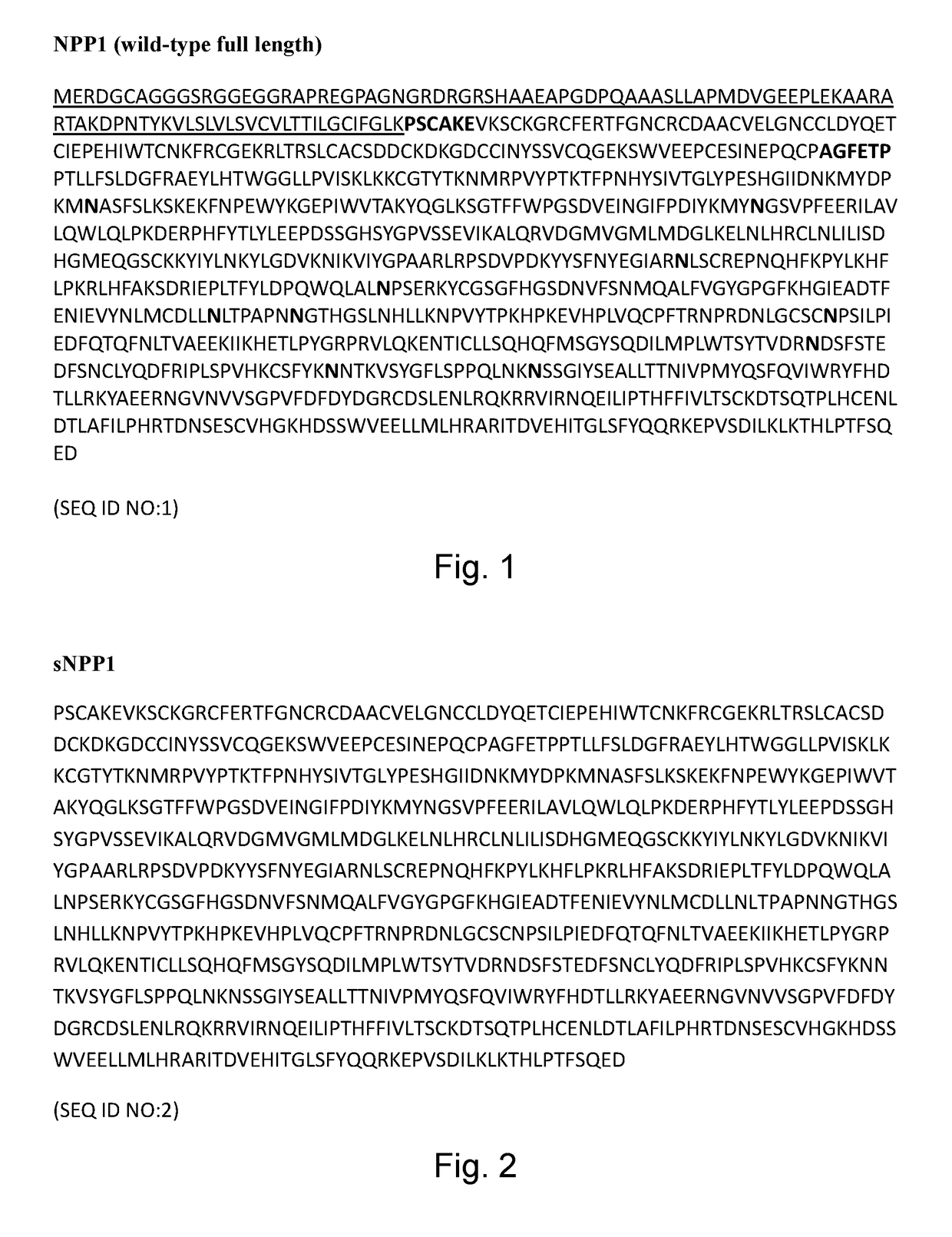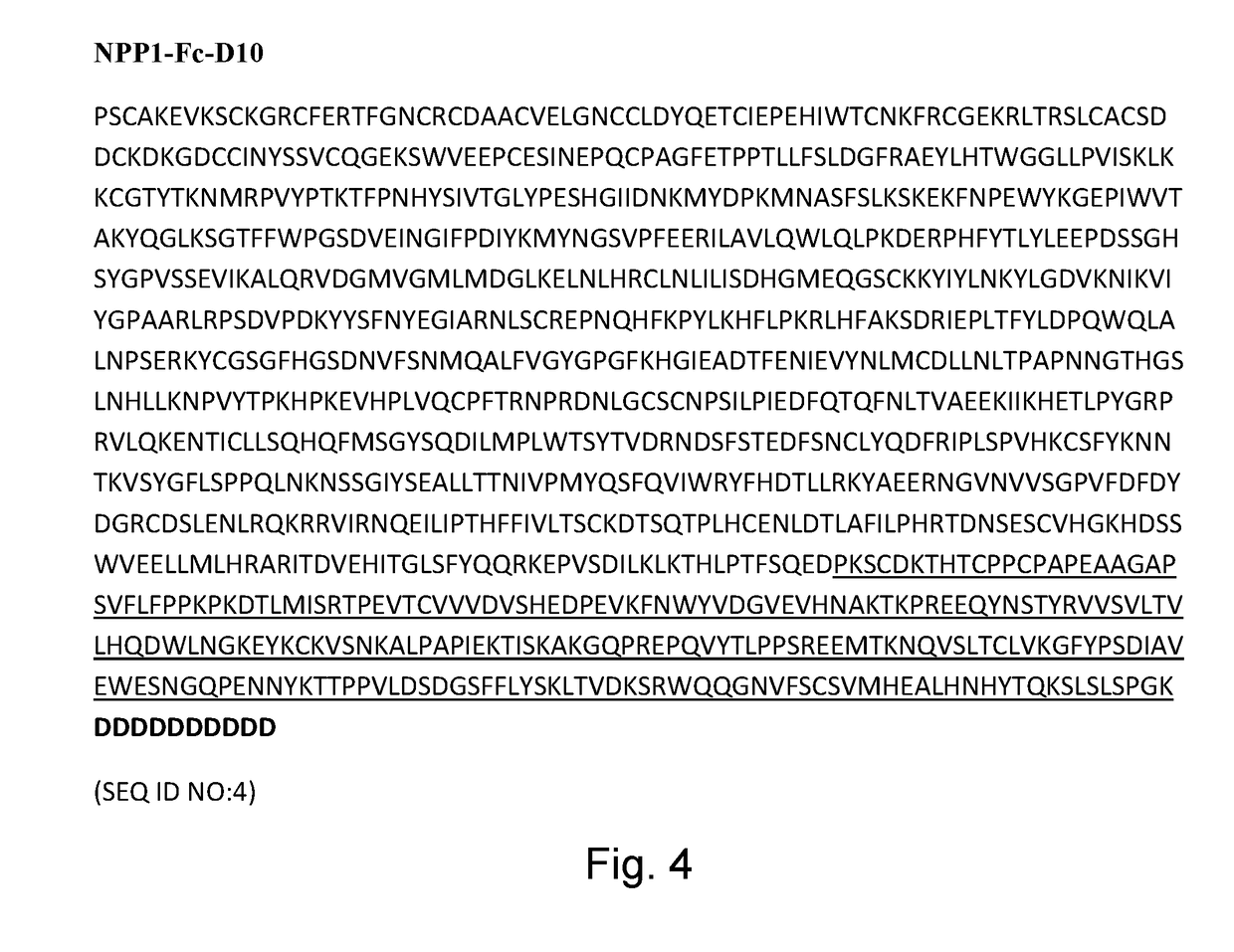Methods of treating tissue calcification
a tissue calcification and tissue technology, applied in the field of tissue calcification treatment, can solve the problems of low levels of circulating and locally produced inhibitors, renal excretion, and inability to treat, and achieve the effect of reducing tissue calcification and transient increase in plasma ppi
- Summary
- Abstract
- Description
- Claims
- Application Information
AI Technical Summary
Benefits of technology
Problems solved by technology
Method used
Image
Examples
examples
[0119]The present invention is further exemplified by the following examples. The examples are for illustrative purpose only and are not intended, nor should they be construed as limiting the invention in any manner.
Methods
Animals:
[0120]Six week old wildtype male C57Bl / 6J mice were used. The average weight of these mice ranged from 21-22 g. Mice were dosed with sNPP1-Fc [1.04 mg / ml] or sNPP1-Fc-D10 [1.03 mg / ml] by subcutaneous (SC) or intravenous (IV) injection at a concentration of 5 mg / kg. Table 1.
TABLE 1IDDrug / RouteTime (h)1No treatment02No treatment03sNPP1-Fc / IV14sNPP1-Fc / IV15sNPP1-FcD10 / IV16sNPP1-FcD10 / IV17sNPP1-Fc / SC48sNPP1-Fc / SC49sNPP1-FcD10 / SC410 sNPP1-FcD10 / SC4
[0121]Two different strains of mice lacking NPP1 were used. Enpp1− / − mice were previously described in Lomashvili, K. A. et al., Kidney Int 2014, 85, 1351-1356. To accelerate arterial calcification, the diet was supplemented with 1.5% phosphate (final phosphorus content: 2%) using a mixture of NaH2PO4 and Na2HPO4 in p...
example i
[0128]Background:
[0129]The experiment was conducted to determine whether there is an increase in PPi levels of wild-type mice that are dosed with variants of sNPP1. For this, 1 hour time point was selected for a single intravenous injection therapy and 4 hour time point for single subcutaneous injection therapy. The estimation of PPi levels was determined by the abcam PPi fluorometric assay.
[0130]Results:
[0131]The raw data from 1 min reads (9 total reads) were averaged and converted to % of normal plasma (WT). Table 2
TABLE 2BlankBlankBufferBufferWT1WT2IV Fc-1IV Fc-2IV D10-1IV D10-2sc Fc-1sc Fc-2sc D10-1sc D10-210.40.432.631.136.240.237.948.051.040.647.045.946.347.320.40.431.530.136.340.837.246.750.839.046.544.646.747.330.40.431.531.135.540.837.045.751.038.846.244.146.046.240.40.431.131.335.540.437.046.049.538.846.645.345.646.250.40.431.229.935.539.735.445.750.338.646.343.746.446.460.30.431.029.835.440.236.044.750.939.045.744.244.444.870.40.430.731.234.239.635.145.550.938.645.843.545...
example ii
[0133]Enpp1(− / −) knock-out mice were treated subcutaneously with vehicle or 6 mg / kg sNPP1-Fc-D10 every other day over a period of 21 days. Aortic calcium levels are shown for males and females. FIG. 6 shows effective prevention of aortic calcification in Enpp1(− / −) mice with sNPP1-Fc-D10 treatment.
PUM
 Login to View More
Login to View More Abstract
Description
Claims
Application Information
 Login to View More
Login to View More - R&D
- Intellectual Property
- Life Sciences
- Materials
- Tech Scout
- Unparalleled Data Quality
- Higher Quality Content
- 60% Fewer Hallucinations
Browse by: Latest US Patents, China's latest patents, Technical Efficacy Thesaurus, Application Domain, Technology Topic, Popular Technical Reports.
© 2025 PatSnap. All rights reserved.Legal|Privacy policy|Modern Slavery Act Transparency Statement|Sitemap|About US| Contact US: help@patsnap.com



